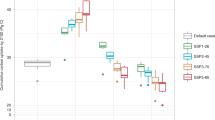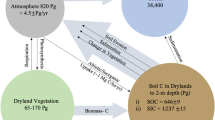Using estimates of land suitable for restoration in woodlands, grasslands, and deserts, as well as estimates of the rate at which restoration can proceed, we estimate that carbon storage in these biomes can range up to 0.8 billion tons of carbon per year (Gt C/yr), for a combination of land management strategies. This corresponds to a reduction in atmospheric buildup of 0.5 Gt C/yr, which represents up to 15% of the average annual atmospheric carbon buildup in the next century, 3.5 Gt C/yr, assuming the IPCC 92d scenario. A global strategy for reducing atmospheric carbon dioxide concentration will require the implementation of multiple options. The advantage of carbon storage in restored drylands is that it comes as a side benefit to programs that are also justifiable in terms of land management.
Similar content being viewed by others
Author information
Authors and Affiliations
Rights and permissions
About this article
Cite this article
Keller, A., Goldstein, R. Impact of Carbon Storage Through Restoration of Drylands on the Global Carbon Cycle. Environmental Management 22, 757–766 (1998). https://doi.org/10.1007/s002679900145
Issue Date:
DOI: https://doi.org/10.1007/s002679900145




